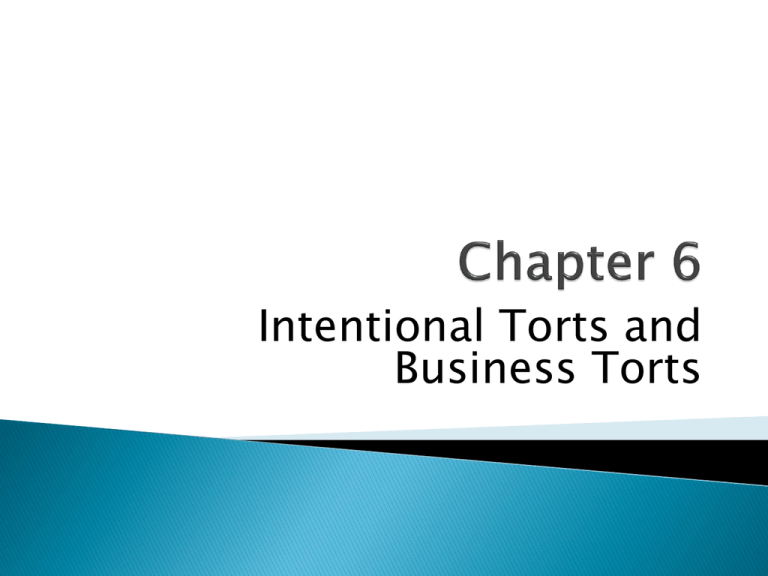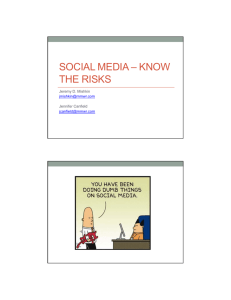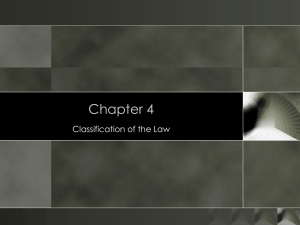Proximate cause
advertisement

Intentional Torts and Business Torts Progress everywhere today does seem to come so very heavily disguised as chaos. Joyce Grenfell, British actor Tort • Violation of a duty imposed by civil law Defamation - Concerns false statements that harm someone’s reputation ◦ Libel: Written defamation ◦ Slander: Oral defamation Elements in a defamation case ◦ ◦ ◦ ◦ Defamatory statement Falseness Communicated Injury Slander Per Se •False statements about sexual behavior, crimes, contagious diseases, and professional abilities Opinion - Generally cannot be proven true or false ◦ Do not usually amount to defamation Related defense - Cases where a supposed statement of fact clearly should not be taken literally Public personalities ◦ Receive less protection from defamation ◦ Can win a defamation case only by proving actual malice by the defendant Actual malice: The defendant knew the statement was false or acted with reckless disregard of the truth Online defamation Privilege ◦ Defendants receive additional protection from defamation cases when it is important for them to speak freely ◦ Absolute privilege: A witness testifying in a court or legislature may never be sued for defamation False imprisonment ◦ Intentional restraint of another person without reasonable cause and without consent ◦ Most commonly arise in retail stores, which sometimes detain employees or customers for suspected theft Intentional Infliction of Emotional Distress • An intentional tort in which the harm results from extreme and outrageous conduct that causes serious emotional harm Battery: An intentional touching of another person in a way that is harmful or offensive Assault: An act that makes a person reasonably fear an imminent battery Fraud: Injuring another person by deliberate deception Money intended to restore a plaintiff to the position he was in before the injury Methods by which damages are calculated: ◦ A plaintiff receives money for medical expenses that he has proven by: Producing bills from doctors, hospitals, physical therapists, and psychotherapists ◦ The defendants are liable for lost wages ◦ A plaintiff is paid for pain and suffering The Single Recovery Principle • Requires a court to settle the matter once and for all, by awarding a lump sum for past and future expenses Damages that are intended to punish the defendant for conduct that is extreme and outrageous Three ‘guideposts’ to consider when awarding punitive damages: ◦ The reprehensibility of the defendant’s conduct ◦ The ratio between the harm suffered and the award ◦ The difference between the punitive award and any civil penalties used in similar cases Occur almost exclusively in a commercial setting Tortious interference with business relations ◦ When healthy competition becomes illegal interference Interference with a contract Interference with a prospective advantage An intentional tort in which the defendant improperly induced a third party to breach a contract with the plaintiff ◦ Exists when: There was a contract between the plaintiff and a third party The defendant knew of the contract The defendant improperly induced the third party to breach the contract or made performance of the contract impossible There was injury to the plaintiff Defendant may also rely on the defense of justification ◦ A claim that special circumstances made its conduct fair ◦ Defendant must show that: It was acting to protect an existing economic interest It was acting in the public interest The existing contract could be terminated at will by either party Malicious interference with a developing economic relationship ◦ There need not be any contract ◦ Plaintiff must show more than just the hope of a profit Intrusion: A tort in which a reasonable person would find the invasion of her private life offensive ◦ For example: Peeping, wiretapping Commercial exploitation ◦ The right to which prohibits the use of someone’s likeness or voice for commercial purposes without permission ◦ Covers the right to make money from publicity To win a negligence case, a plaintiff must prove: ◦ ◦ ◦ ◦ ◦ Duty of due care Breach Factual cause Proximate cause Damages Special duty - Landowners ◦ Lowest liability - Trespassing adults Trespasser: A person on another’s property without consent ◦ Mid-level liability - Trespassing children ◦ Higher liability - Licensee Licensee: A person on another’s land for her own purposes but with the owner’s permission ◦ Highest liability - Invitee Invitee: A person who has a right to enter another’s property because it is a public place or a business open to the public ◦ Special duty - Professionals ◦ Special duty - Hiring and retention If a legal duty of care exists, then a plaintiff must show that the defendant did not meet it ◦ Negligence per se Factual cause: When the defendant’s breach led to the ultimate harm Proximate cause: For the defendant to be liable, the type of harm must have been reasonably foreseeable Res ipsa loquitur: The facts imply that the defendant’s negligence caused the accident ◦ Applies when: The defendant had exclusive control of the thing that caused the harm The harm normally would not have occurred without negligence The plaintiff had no role in causing the harm Plaintiff must prove that he has been injured or that he has had some kind of measureable losses Contributory negligence: If the plaintiff is even slightly negligent, he/she recovers nothing Comparative negligence: A plaintiff may generally recover even if he/she is partially responsible Assumption of the Risk • A person who voluntarily enters a situation that has an obvious danger cannot complain if she is injured Imposes a much higher level of liability when harm results from ultrahazardous acts or defective products ◦ Ultrahazardous activities Using harmful chemicals Operating explosives Keeping wild animals Bringing dangerous substances onto property Activities where the danger to the general public is especially great One who sells any product in a defective condition, unreasonably dangerous to the consumer is subject to liability for physical harm thereby caused to the consumer, if: ◦ The seller is engaged in the business of selling such a product ◦ It is expected to and does reach the consumer without substantial change in the condition in which it is sold The rule stated in Subsection (1) applies although: ◦ The seller has exercised all possible care in the preparation and sale of his product ◦ The user or consumer has not bought the product from or entered into any contractual relation with the seller Consumer expectation – Where a court finds the manufacturer liable for defective design if: ◦ The product is less safe than a reasonable consumer would expect Risk-utility test - Principal factors include: The value of the product The gravity, or seriousness, of the danger The likelihood that such danger will occur The mechanical feasibility of a safer alternative design ◦ The adverse consequences of an alternative design ◦ ◦ ◦ ◦ “Although tortious acts and their consequences are diverse, two generalities apply. First, the boundaries of intentional torts are imprecise, the outcome of a particular case depending to a considerable extent upon the fact finder who analyzes it. Second, the thoughtful executive and the careful citizen, aware of the shifting standards and potentially vast liability, will strive to ensure that his or her conduct never provides that fact finder an opportunity to give judgment.”







